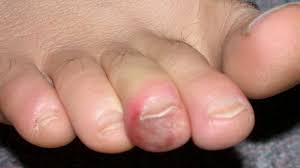
In preparation for winter, as we transition into closed footwear and cooler climates, there are some changes that can occur to our daily routine which can affect the feet. In this blogpost, we will discuss a few quick tips on how to best look after your feet to avoid some very common foot issues in winter.
Corns in between the toes or on top from closed footwear rubbing
What is a corn?
Corns are thick, hardened layers of skin that develop when your skin tries to protect itself against friction and pressure. They commonly occur on the outside of the little toe, in between toes, on the top and bottom of clawed toes and also on the bottom of the foot.
Tips
Wearing footwear that are of the correct length and have a good depth in the toe box.
If you are not sure, bring your shoes to your podiatrist consult and we will be happy be check these for you.
Change your shoes up! if you are wearing the same ones all the time then the pressure areas are going to be in the same area.
How can a podiatrist help
Frequent hard skin removal
Footwear advice .
Products such as toe separators and toe cushions.
Orthotics to change where pressure is felt in the foot.
Chilblains
What are chilblains ?
Chilblains (CHILL-blayns) are the painful inflammation of small blood vessels in your skin that occur in response to repeated exposure to cold but not freezing air. They often flair up in winter months when moving from cold to warm areas.
Tips
Try and limit going from cold to warm areas as much as possible.
Ensure that your shoes are the correct size and your socks are not too tight.
Use Akileine Akilhiver chilblains cream which helps to retain the body's heat while soothing itching and providing skin relief.
How can a podiatrist help
Providing a paraffin wax treatment that helps to open blood vessels and warm toes.
Using Laser to help improve micro-circulation in the toes.
Improving skin conditions via blister prevention and moisturising the skin, debriding any corns and calluses.
Proving footwear and sock advice.
Tinea
What is Tinea ?
Tinea is is a fungal infection that usually begins between the toes or on the bottom of the foot. It can be itchy, red and peeling. You may be more prone to it in winter if you have to wear closed footwear more and thicker socks, creating the perfect warm, dark, moist environment which fungal infection loves to grow in.
Tips
Dry well between shoes after showering.
Change socks regularly and wear natural fibres such as cotton where possible.
Wash your socks in an anti fungal solution.
Use products to help dry in between your toes such as tea tree oil spray.
Use a topical anti fungal cream.
How can a podiatrist help?
Use a machine to sterilise your shoes.
Monitor progression of Tinea in places where it is difficult for you to see.
Providing advice to guide you out of dealing with ongoing fungal infections.
Bunion pain
What is a bunion?
A bunion is a bony bump that forms on the joint at the base of your big toe. It occurs when some of the bones in the forefoot move out of place. This causes the tip of your big toe to get pulled toward the smaller toes and forces the joint at the base of your big toe to stick out.

Tips when purchasing new shoes
Rounded ends of shoes rather than pointy ones.
Wider shoe at the front to accommodate the bunion.
Adequate depth of so your foot is not rubbing on the top.
Buying a shoe which is low heeled to reduce the pressure on the forefoot.
A soft top material or seamless upper which can stretch out and not apply extra pressure to the bunion.

How can a podiatrist help?
Footwear advice.
Taping.
Padding the shoes to reduce pain .
Dry needling and shockwave therapy to loosen up muscles causing the bunion.
Protection devices, such as a toe separator (pictured above) or a bunion sleeve.
If you need further information or book into see one of our friendly podiatrists, please contact us on (03) 8648 7678 if you have any questions!






















コメント